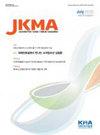心脏骤停后综合征的处理
IF 0.5
Q3 MEDICINE, GENERAL & INTERNAL
引用次数: 0
摘要
背景:尽管复苏科学取得了各种进展,但心源性猝死患者的总体生存率仍然很低。无论塌陷的原因是什么,继发于心脏骤停综合征的多器官系统可能受到损伤。本专栏强调了可以纳入复苏后护理的干预措施,以缩小自然循环恢复(ROSC)和神经系统完整生存之间的差距。当前概念:心脏骤停后护理算法提出了在初始稳定阶段要考虑的治疗策略和治疗目标,其次是调查心脏骤停的原因和重症监护策略,以减少额外的脑损伤。在ROSC后,立即将ROSC后护理所需的多模式干预措施捆绑到护理方案中(治疗可逆原因,充分的癫痫发作管理和血糖控制)。建立明确的气道管理以维持正热通气、防止高氧和优化血流动力学管理也是至关重要的。ROSC后的目标温度管理可提供神经保护并改善神经预后。讨论与结论:心脏骤停后护理也被强调为生存链中的关键要素。概述的干预措施可能会导致更多的患者活着出院,并具有良好的神经功能。此外,还包括持续的管理计划,如心脏骤停幸存者的二级预防和社会康复,以及在一段时间后未恢复意识的患者的神经预后。本文章由计算机程序翻译,如有差异,请以英文原文为准。
Management of post-cardiac arrest syndrome
Background: Despite various advances in resuscitation science, the overall survival outcome remains very low in patients who sustain sudden cardiac death. Regardless of the cause of the collapse, multiple organ systems may be injured secondary to post-cardiac arrest syndrome. This column highlights the interventions that can be incorporated as a bundle of post-resuscitation care, to narrow the gap between return of spontaneous circulation (ROSC) and neurologically intact survival.Current Concepts: The post-cardiac arrest care algorithm presents treatment strategies and therapeutic goals to be considered in the initial stabilization stage, followed by investigating the cause of cardiac arrest and intensive care strategies to reduce additional brain damage. Immediately after ROSC, multimodal interventions required for post-ROSC care are bundled into a care regimen (treatment of the reversible cause, adequate seizure management, and glycemic control). It is also essential to establish definitive airway management to maintain normocapnic ventilation, prevent hyperoxia, and optimize hemodynamic management. Targeted temperature management after ROSC confers neuroprotection and leads to improved neurological outcomes.Discussion and Conclusion: Post-cardiac arrest care is also emphasized as a key element in the chain of survival. The interventions outlined could lead to more patients being discharged alive from the hospital, with good neurological function. In addition, continued management planning, such as secondary prevention and social rehabilitation for cardiac arrest survivors and neurological prognostication for patients who do not recover consciousness after a certain period, are included.
求助全文
通过发布文献求助,成功后即可免费获取论文全文。
去求助
来源期刊

Journal of The Korean Medical Association
Medicine-General Medicine
CiteScore
0.50
自引率
0.00%
发文量
84
审稿时长
4-8 weeks
期刊介绍:
The Journal of the Korean Medical Association (JKMA) is the official peer-reviewed, open-access, monthly journal of the Korean Medical Association (KMA). It contains articles in Korean or English. Its abbreviated title is ''J Korean Med Assoc''. The aims of the Journal include contributing to the treatment of and preventing diseases of public health importance and to improvement of health and quality of life through sharing the state-of the-art scientific information on medicine by the members of KMA and other national and international societies.
 求助内容:
求助内容: 应助结果提醒方式:
应助结果提醒方式:


